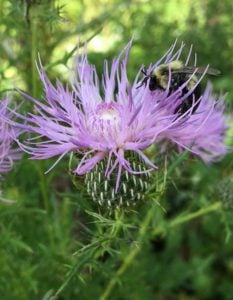
On a sunny August day, as I weed among the bee balm and tickseed, some of my favorite garden companions are likely to bustle by: bumblebees.
They never move fast, but they never stay still. Every moment of a bumblebee’s day is busy, collecting nectar for food and pollen to feed the young. I love to watch one hop from flower to flower, canvassing each bloom with the focus of a Chicago precinct captain knocking on doors on Election Day.
All my native prairie flowers attract bumblebees; that’s a big reason I plant them. However, I’m forced to admit that the super bee magnet in my garden, the plant that always seems to be alive with a dozen kinds of bees, is fluffy pale purple calamint (Calamintha nepeta), a European import.
All bees are beneficial to a garden, since they spread pollen from flower to flower and help the plants reproduce. No bees, no tomatoes. Still, I find myself more attracted to bumblebees than to European honeybees (although I’ll take the honey). Why? I guess because they’re prominent and appealingly fuzzy, and they’re convenient.
Bumblebee spotting is easy because they’re so big and so slow. That makes it possible to notice the different kinds, some much bigger or much fuzzier or less striped than others. I hear there are 11 bumblee species among the 3,000 or so species of native bees in Illinois, although I’m not convinced I could identify any of them.
Bumblebees (once called “dumbledores”) have a reputation for being clumsy and, well, bumbling, perhaps because they fly so slowly. Personally, I think they’re more deliberate than clumsy. I’ve never seen a bumblebee that didn’t seem to know exactly what it was doing.
It’s for the sake of bees, and all other insects and the birds that eat them, that I never use insecticides in my garden. I’d hate to poison honeybees, or whizzing hawk moths, or fat, fuzzy bumblebees before their time.
In August, a bumblebee’s life is already near its close. Each spring a new nest starts when a mated queen chooses a nest site–usually a hole in the ground–and lays eggs. They hatch into a couple of hundred worker bees, the ones I see busy in my garden, collecting food for their younger sisters back at the nest. By fall, a new queen will emerge, find a male, mate, and tuck herself away for the winter. All the other bees will die.
Maybe it’s because I know their lives are short that the company of these bees seems so sweet to me. As long as the bumblebees are busy, it’s still summer in the garden.


